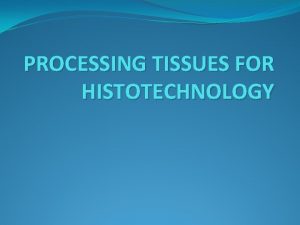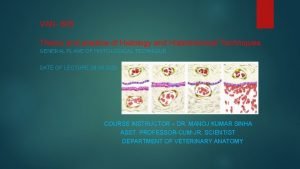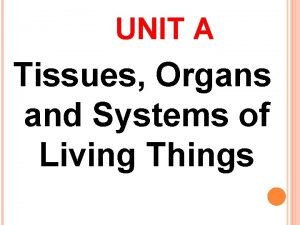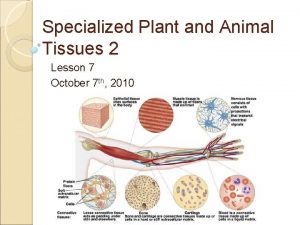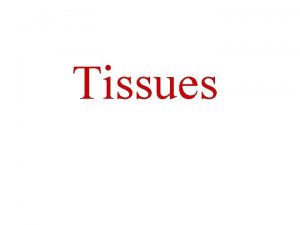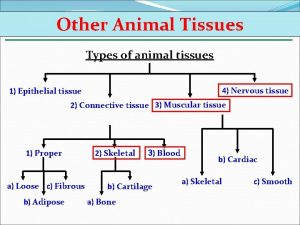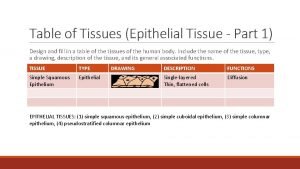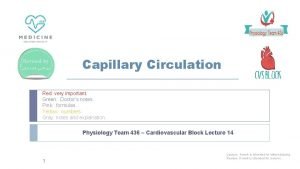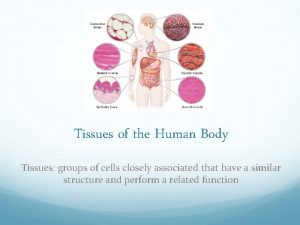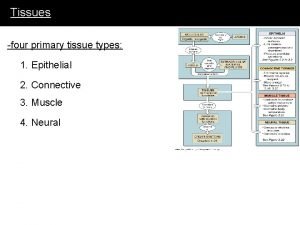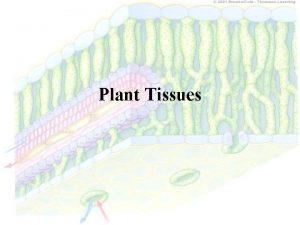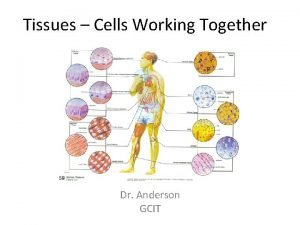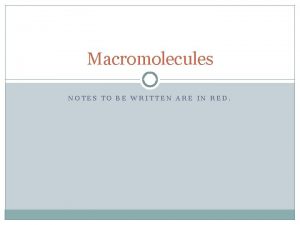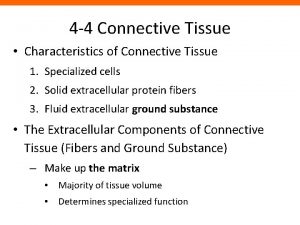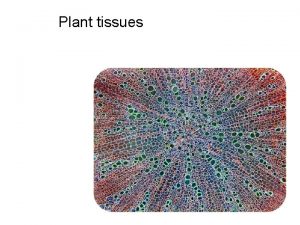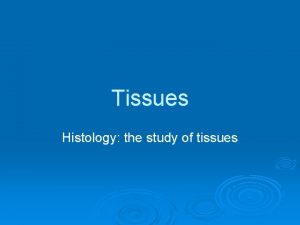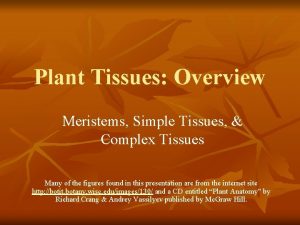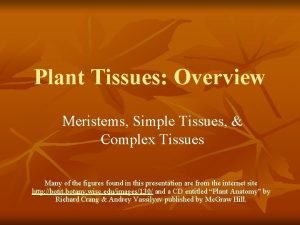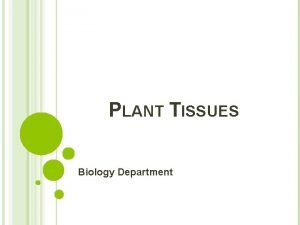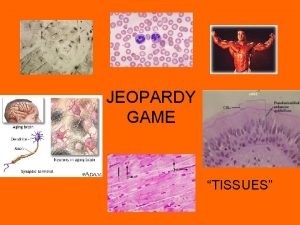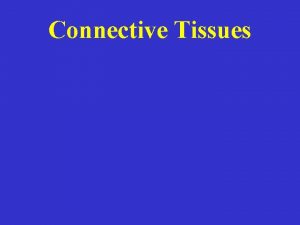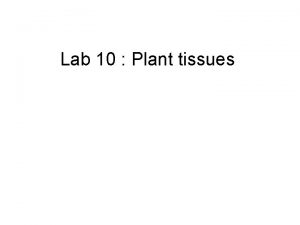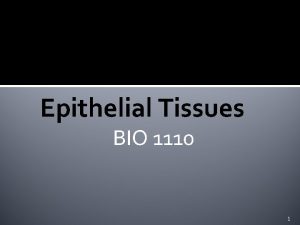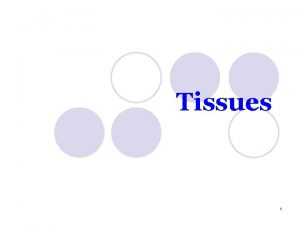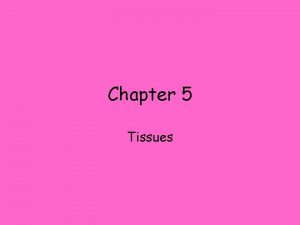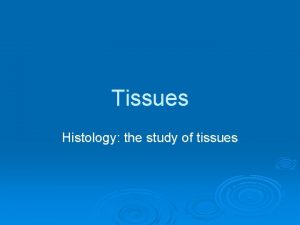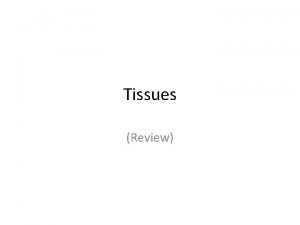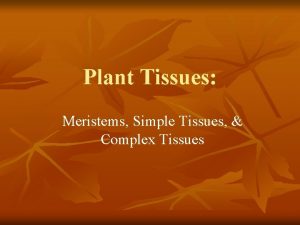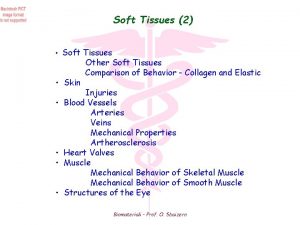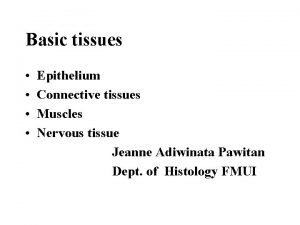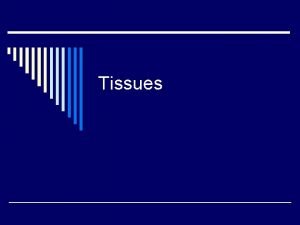PROCESSING TISSUES FOR HISTOTECHNOLOGY PROCESSING TISSUES FOR HISTOTECHNOLOGY




































































































- Slides: 100

PROCESSING TISSUES FOR HISTOTECHNOLOGY

PROCESSING TISSUES FOR HISTOTECHNOLOGY INTRODUCTION A series of processes are done on a tissue before a microscopic examination �Fixation �Dehydration �Clearing �Embedding �Cutting �Staining

PROCESSING TISSUES FOR HISTOTECHNOLOGY PRESERVATION OF TISSUES �The aim of ideal fixation is to preserve the tissue in as lifelike manner as possible �Only the very rapid freezing of small pieces of tissues in iso-pentane in liquid nitrogen (-160℃) will actually achieve this purpose

PROCESSING TISSUES FOR HISTOTECHNOLOGY DEFINITION OF FIXATION �This is the process by which the constituents of the cells, and therefore of the tissues, are fixed in a physical, and partly also in a chemical, state so that they will withstand subsequent treatment with various reagents.

PROCESSING TISSUES FOR HISTOTECHNOLOGY FIXATION Ideally a fixative should �Penetrate the tissue quickly �Be rapid in action �Be isotonic �Cause a minimum loss and minimum physical and chemical alteration of tissue and its components �Be cheap, stable and safe to handle �It should not bind with staining chemicals

PROCESSING TISSUES FOR HISTOTECHNOLOGY EFFECTS OF FIXATIVES ON TISSUES �Most fixatives produce tissue hardening �Certain fixatives act as mordants for stains e. g. , mercuric fixatives �They usually increase the optical differentiation of cell and tissue components �They render the cells insensitive to hypo- and hypertonic solutions �Microorganisms also get fixed and prevent decomposition

PROCESSING TISSUES FOR HISTOTECHNOLOGY �THE IDEAL FIXATIVE 1 - Prevent autolysis and bacterial decomposition 2 - Preserve tissue in their natural state and fix all components 3 - Makes the cellular components insoluble to liquids encountered in the tissue processing 4 - Preserves tissue volume 5 - Avoid excessive hardness of fixed tissue 6 - Allow enhanced staining of tissues 7 - Be nontoxic and non-allergenic

PROCESSING TISSUES FOR HISTOTECHNOLOGY �GENERAL PRINCIPLES IN HANDLING AND FIXATION OF SPECIMENS 1 - Amount of fixing fluid It should be 10 -20 times the volume of specimen 2 - Surgical specimens These should be placed in an adequate amount of fixative as soon as possible after removal 3 - Autopsy material Autopsy examination should be performed as soon after death as possible. Slices of organs taken at autopsy should be thin to facilitate fixation.

PROCESSING TISSUES FOR HISTOTECHNOLOGY ROUTINE FIXATIVES �Formaldehyde ; Formalin �Metallic Fixatives ; include, Mercury fixatives, Chromate fixatives �Picric Acid Fixatives �Alcohol Fixatives

PROCESSING TISSUES FOR HISTOTECHNOLOGY Formaldehyde ; Formalin �Commercial formaldehyde is a saturated solution of formaldehyde (H. CHO) gas in water, 40% gas by weight. � A mixture of 10 m. L formalin with 90 m. L of water and saline is known a 10 % formalin �Formation of para-formaldehyde �Formation of formic acid

PROCESSING TISSUES FOR HISTOTECHNOLOGY Nature of Formalin Action �The aldehyde group in formalin permits many reactions with tissue components especially polymerization action. �Resulting in alteration in cell physio-chemistry �Reactivity of tissues towards certain histochemical stains alters �Such changes can be altered by washing the specimen with water or by putting the specimen in formalin for about 6 -24 hours

PROCESSING TISSUES FOR HISTOTECHNOLOGY Formalin fixation and temperature �A block of average tissue (not fatty) upto 4 mm thick will be adequately fixed in 10 -20 times its volume of buffered neutral formalin in about 8 hours at room temperature �Time can be shortened 25 -40% if the fixative’s temperature is raised to 45℃

PROCESSING TISSUES FOR HISTOTECHNOLOGY Advantages of formalin �Its cheap, easy to prepare and is relatively stable �No special preliminary procedure is done before staining �Frozen sections can be done more easily after formalin fixation �Staining of fat can be easily done after its use �Tissue enzyme study can be done �Tissue penetration is well. Rendering them neither much hard nor brittle �Natural tissue color can be restored with no great difficulty �It’s the best fixative for CNS

PROCESSING TISSUES FOR HISTOTECHNOLOGY Disadvantages of Formalin �Dermatitis of hands �Its fumes cause irritation to the nostrils �Asthma in allergic individuals �The National Institute for Occupational Safety and Health (NIOSH)recommends that no worker be exposed to more than 1 part per million (ppm)of formaldehyde for any 30 minute period. �Reduction in pulmonary ventilating capacity is seen in industrial exposures. �It forms dark-brown artifact pigment granules in spleen

PROCESSING TISSUES FOR HISTOTECHNOLOGY REMOVAL OF FORMALIN PIGMENT Its relatively simple and is achieved by either of the following methods �Kardasewitsch’s Method. 1. Bring sections down to water 2. Place the sections for 5 minutes to 3 hours, depending on amount of pigment, in a mixture of 70% ethyl alcohol 100 ml 28% ammonia water 1 or 2 ml 3. Wash thoroughly in water

PROCESSING TISSUES FOR HISTOTECHNOLOGY Lillie's Method. �After bringing down to water, place the sections for 1 to 5 minutes in a mixture of Acetone 50 ml 3 vol hydrogen peroxide 50 ml 28% ammonia water 1 ml �This should be followed by washing in 70% alcohol and then in running water. �Picric Acid. Place sections (after bringing to water) in a saturated alcoholic solution of picric acid for 5 minutes to 2 hours. Then wash for 10 to 15 minutes in running tap water.

PROCESSING TISSUES FOR HISTOTECHNOLOGY Routine Formalin Fixatives �Traditionally formol-saline (usually buffered) has been the most commonly used fixative in pathology. � 10% Formol-Saline Water (preferably distilled) 900 m. L Sodium chloride 8. 5 g Formalin 100 m. L �For better results, however, one should use buffered neutral formalin as recommended by Lillie. � 10% Buffered Neutral Formalin Water (distilled) Na. H 2 PO 4 (anhydrous) Na 2 HPO 4. (anhydrous) Formalin 900 m. L 3. 5 g 6. 5 g 100 m. L

PROCESSING TISSUES FOR HISTOTECHNOLOGY �For the hydrated salts the quantities are: Na. H 2 PO 4. H 20 4. 02 g Na 2 HPO 4· 12 H 20 16. 37 g/L �Storage of specimens in 10% buffered formalin is suitable for most routine purposes, but the use of 70% ethyl alcohol or 10 to 20% diethylene glycol in water is considered better because, even with buffered formalin, there is gradual loss in basophilic staining of the cytoplasm and nucleus, together with loss in reactivity of myelin to the Weigert iron hematoxylin method.

PROCESSING TISSUES FOR HISTOTECHNOLOGY Formalin and Lipids �It is largely inert towards lipids �It fixes some complex and unsaturated lipids �Neutral fats remain unaltered �Formol-mercuric chloride is better �Chromation after use of calcium cobalt will cause even more lipids to be retained in liquid paraffin sections �Due to its polymerizing action, formalin tends to reduce the PAS positivity of reactive mucin

PROCESSING TISSUES FOR HISTOTECHNOLOGY Secondary Fixation (postmordanting) �Some laboratories use this technique for special purposes e. g. , metachromasy, trichrome staining, and for the chromaffin reaction. �Secondary fixation. �Blocks that have been in formalin for 1 to 4 hours are placed for 4 to 6 hours in Helly’s fulid, or preferably, for 4 to 16 hours in formol-mercuric chloide. Mercuric chloride 30 g Distilled water 900 ml Formalin 100 ml

PROCESSING TISSUES FOR HISTOTECHNOLOGY Metallic Fixatives 1 - Mercury Fixatives 2 - Chromate Fixatives

PROCESSING TISSUES FOR HISTOTECHNOLOGY MERCURY FIXATIVES Formulas of Mercuric Salt Fixatives ZENKER'S Mercuric chloride (Hg. CI 2) 50 g Potassium dichromate 25 g Sodium sulfate (often omitted) 10 g Distilled water 1000 m. L �Add 50 m. L (5 m. L/d. L stock) of glacial acetic acid just before use. �After treatment with Zenker's fixative the potassium dichromate deposit should be removed by washing the tissue in running water for at least an hour (preferably overnight) before dehydration and the removal of the mercuric deposit. The tissue blocks are then placed in 70% ethanol.

PROCESSING TISSUES FOR HISTOTECHNOLOGY SCHAUDl. NN'S "SUBLIMATED ALCOHOL" Mercuric chloride 3 g Distilled water 50 m. L �Dissolve the Hg. Cl 2 in the water by shaking, and then add 25 m. L of absolute ethyl alcohol. This is probably the most useful fixative for making smears of loose cells on a slide, following which they are less likely to detach during staining than with any other fixative.

PROCESSING TISSUES FOR HISTOTECHNOLOGY �Chromate fixatives � 2. 5% Potassium dichromate (K 2 Cr 207), aqueous 100 m. L Sodium sulfate (optional) 1 g Add, just before using, Formalin solution 10 m. L Regaud's (Moller's) Fluid 3% Potassium dichromate 80 m. L Add, just before using Formalin 20 m. L

PROCESSING TISSUES FOR HISTOTECHNOLOGY PICRIC ACID FIXATIVES Brasil’s Alcoholic Picro-Fromol Fixative �The following is a modified Brasil formula Formalin 2040 m. L Picric acid (BDH: 50% water) 80 g Ethanol or isopropyl alcohol 6000 m. L Trichlro-acetic acid 65 g

PROCESSING TISSUES FOR HISTOTECHNOLOGY ALCOHOLIC FIXATION �It denatures and precipitates protein �Methyl alcohol 80 -100% is an excellent fixative for smears �In concentrations below 80% it is of causes lysis of cells �Ethyl alcohol is used for fixation of enzymes �Unless used at 0℃ or cooler it causes severe shrinkage �They are contraindicated when lipids are to be studied

PROCESSING TISSUES FOR HISTOTECHNOLOGY SPECIAL FACTORS AFFECTING FIXATION �Size and thickness of piece of tissue �Tissues covered by or containing mucus are fixed slowly and poorly e. g, pseudomucinous cyst �The same applies to blood containing organs like lungs �Fatty and lipomatous tissue fix slowly. So, the blocks should be thin �Moderate heat (37 to 56℃) will accelerate fixation �Fixation is also accelerated by agitation

PROCESSING TISSUES FOR HISTOTECHNOLOGY COMPATIBILITY AND INCOMPATIBILITY OF FIXATIVES AND STAINS �Few fixatives permit the use of all stains �One and the same fixative may act as mordant for one group of dyes and an inhibitor for another set of stains �With some fixatives must be thoroughly washed from the tissues before many stains may be used

PROCESSING TISSUES FOR HISTOTECHNOLOGY SOFTENING HARD TISSUES �Some tissues like cervix, fibroids, some hyperkeratotic skin lesions, and finger nails �Lendrum’s method is used for softening such tissues before processing �Benzene or chloroform instead of xylene will reduce hardness

PROCESSING TISSUES FOR HISTOTECHNOLOGY DECALCIFICATION �The cutting of thin sections by ordinary methods is impossible in the case of bone, teeth, also many calcified pathological lesions seen in tuberculous foci or calcified atheromas �Acids are used in which bone salts are dissolved �All such acids damage the ground substance of the bone �So 2 -4 mm thick blocks are fixed in a buffered neutral formalin for 2 -4 days or in Zenker’s solution for 15 -24 hours �It will render the nucleic acid resistant to hydrolytic action of acids

PROCESSING TISSUES FOR HISTOTECHNOLOGY DECALCIFICATION �Heat will accelerate the process of demineralization but it will also increase the destructive action of acid on matrix �Effect of agitation is little in acid solution �Use of partial or complete vacuum is same

PROCESSING TISSUES FOR HISTOTECHNOLOGY DECALCIFICATION Usually 2 types of acids are used for decalcification purposes 1 - Nitric acid 2 - Formic acid �The volume of decalcifying solution should be at least 1 oz per g of tissue �It should be changed once or twice a day until decalcification is completed �The bone block should rest on a gauze platform supported by a glass rod in the middle of the fluid in glass jar

PROCESSING TISSUES FOR HISTOTECHNOLOGY DECALCIFICATION TESTS FOR COMPLETION OF DECALCIFICATION �By touch, pliability, and resistance to finger nail �By needling, by x-ray, or by chemical testing of decalcifying fluid Chemical testing �In a clean test tube place decalcifying fluid for 3 -12 hours �Alkalinize the litmus paper by carefully adding ammonia water �Add 0. 5 ml saturated ammonium oxalate, mix and let it stand for 15 -30 minutes

PROCESSING TISSUES FOR HISTOTECHNOLOGY DECALCIFICATION �If fluid remains clear, decalcification is completed �If cloudiness appears, it means decalcification is not complete

PROCESSING TISSUES FOR HISTOTECHNOLOGY PARAFFIN SECTIONS OF ASPIRATED BONE MARROW �It is usually obtained by aspiration needle �Sternal puncture is done �Smears are done as soon as possible from freshly obtained marrow �The left over is placed in 50 -100 m. L of fixative

PROCESSING TISSUES FOR HISTOTECHNOLOGY FIXATIVE FOR ASPIRATED BONE MARROW �Formaldehyde (40) % �Glacial acetic acid �Sodium sulfate �Distilled water 200 ml 165 ml 60 gm 1000 ml

PROCESSING TISSUES FOR HISTOTECHNOLOGY PROCESSING OF ASPIRATED FRAGMENTS �Place the aspirated fragments in 50 -100 ml of fixative. Mix by inversion or by figure-of-8 motion. Allow to fix for 3060 minutes �Pour off the bulk of the supernatant fixative and place the remainder, together with the marrow fragments, in a petri dish on a black background �Using Pasteur pipette select all the white marrow fragments and place in a test tube. As soon as the fragments have settled, aspirate the remainder of the fixative with the pipette

PROCESSING TISSUES FOR HISTOTECHNOLOGY �Fill the tube to within ½ cm of top with 50% ethyl alcohol. Stopper and mix by inversion. Let stand 20 minutes; pipette off the supernatant �Replace with 70% alcohol. Let stand 20 minutes; pipette off the supernatant �Replace with 90% alcohol for 15 minutes �Replace with absolute alcohol for 15 -20 minutes �Replace with fresh absolute alcohol for 15 -20 minutes �Replace alcohol xylol. Stand 1 hour �Replace with fresh xylol. Let it stand for 1 -2 hours

PROCESSING TISSUES FOR HISTOTECHNOLOGY �Pipette off the xylol. Place the tube in wax oven and fill with molten wax. Let it stand for 1 hour in the oven �Replace with fresh wax and allow to remain in the wax oven for 1 -2 hours more �Replace with fresh embedding wax; remove from the oven and allow to set �Immerse for 5 minutes in cold tap water to harden �Carefully break the tube, removing all fragments of glass. Mount the block ready for sectioning

PROCESSING TISSUES FOR HISTOTECHNOLOGY AUTOMATED TISSUE PROCESSING �Dehydration, clearing and preparation for embedding are usually accomplished by the use of automated tissue processors �They work on the principle of a central, rotating spindle that carries a “basket” suspended from the outer end of a radial arm. The spindle is automatically lowered, bringing the basket into the solution.

PROCESSING TISSUES FOR HISTOTECHNOLOGY AUTOMATED TISSUE PROCESSING �A short, repetitive, up an down motion of the entire head assembly or arm, or a separate motor on the basket-carrying arm, continuously moves the basket in the solutions �This movement is important as it speeds up the interchange between chemicals and tissues � 2 metal beakers or containers hold the wax, which is kept molten and at a constant temperature by thermostats within the walls of the beakers


AUTOMATED TISSUE PROCESSING 16 - Hour Schedule �Starting time: 4 P. M. � 10% (buffered neutral formalin Changed daily � 70% Ethyl alcohol � 80% Ethyl alcohol � 90% Ethyl alcohol � 100% Ethyl alcohol 4 hr 1 hr 1 hr

AUTOMATED TISSUE PROCESSING �Toluene or chloroform �Wax Paraplast 1 hr 2 hr

PRINCIPLES OF TISSUE PROCESSING

PRINCIPLES OF TISSUE PROCESSING �Tissue processing is designed to remove all extractable water from the tissue, replacing it with a support medium that provides sufficient rigidity to enable sectioning of the tissue without damage or distortion.

PRINCIPLES OF TISSUE PROCESSING Stages of tissue processing are: �dehydration: removal of water and fixative from the tissue �clearing: removal of dehydrating solutions. making the tissue components receptive to the infiltrating medium �infiltrating: permeating the tissue with a support medium �embedding: orienting the tissue sample in a support medium and allowing it to solidify

Factors influencing the rate of processing �When tissue is immersed in fluid, interchange occurs between the tissue and the surrounding fluid. Several factors influence the rate at which interchange occurs. �Agitation �Heat �Viscosity �Vacuum �Fixation �Dehydration

Agitation �The rate of fluid exchange is dependent upon the exposed surface of the tissue that is in contact with the processing reagent. � Agitation increases the flow of fresh solutions around the tissue. � Automated processors incorporate vertical or rotary oscillation or pressurized removal and replacement of fluids at timed intervals as the mechanism for agitation. �Efficient agitation can reduce the overall processing time by 30%.

Heat �Heat increases the rate of penetration and fluid exchange. �It must be used sparingly to reduce the possibility of shrinkage, hardening, and brittleness of the tissue. �Temperatures limited to 45°C can be used effectively; higher temperatures may be deleterious to subsequent immuno-histochemical staining.

Viscosity �Viscosity is the property of resistance to the flow of a fluid. The smaller the size of the molecules in the solution, the faster the rate of fluid penetration (low viscosity). �Embedding mediums have varying viscosities. Paraffin has a lower viscosity in the fluid (melted) state, enhancing the rapidity of the impregnation.

Vacuum �Using reduced pressure to increase the rate of infiltration decreases the time necessary to complete each step in the processing of tissue samples. �Vacuum used on the automated processor should not exceed 15 inches of Hg (mercury) to prevent damage and deterioration to the tissue. Vacuum can aid in the removal of trapped air in porous tissue. �Impregnation time of dense, fatty tissue can be greatly reduced with the addition of vacuum during processing.

Fixation �Preserving cells and tissue components with minimal distortion is the most important step in the processing of tissue samples �Fixation stabilizes proteins, rendering the cell and its components resistant to further autolysis by inactivating lysosomal enzymes, and changes the tissues receptiveness to further processing. Fixation must be complete before subsequent steps in the processing schedule are initiated.

Maintenance of Automated Processor �An adequate exhaust ventilating system �Electrical supply should be ensured �An automatic switch to an emergency generator in case of a power failure �All beakers should be kept filled with correct strength fluids to correct levels �Beakers are firmly placed �Any spillage should be cleaned immediately �Temperatures of paraffin wax containers is maintained by an electrical supply, so that it is molten all the time

DEHYDRATION �The first stage of processing is the removal of unbound water and aqueous fixatives from the tissue components. �Many dehydrating reagents are hydrophilic ('water loving') possessing strong polar groups that interact with the water molecules in the tissue. Other reagents affect dehydration by repeated dilution of the aqueous tissue fluids. Dehydration should be accomplished slowly.

DEHYDRATION �If the concentration gradient between the fluid inside and outside the tissue is excessive, diffusion currents cross the cell membranes during fluid exchange, increasing the possibility of cell distortion. �For this reason specimens are always processed through a graded series of reagents of increasing concentration. �Excessive dehydration may cause the tissue to become hard, brittle, and shrunken.

DEHYDRATION �Incomplete dehydration will prohibit the penetration of the clearing reagents into the tissue, leaving the specimen soft and non-receptive to infiltration. �There are numerous dehydrating agents: ethanol, ethanol acetone, methanol, isopropyl, glycol and denatured alcohols. �If the dehydrant of choice is ethanol, the tissue is first immersed in 70% ethanol in water, followed by 95% and 100% solutions. For delicate tissue it is recommended that the processing start in 30% ethanol.

Ethanol C 2 H 50 H �This is a clear, colorless, flammable liquid. �It is hydrophilic, miscible with water and other organic solvents, fast acting, and reliable. �Ethanol is taxable controlled by the federal government, and requires careful record keeping. �Graded concentrations of ethanol are used for dehydration. Ethanol ensures total dehydration, making it the reagent of choice for the processing of electron microscopy specimens.

Industrial methylated spirit ( denatured ethyl alcohol) �This has the same physical properties as ethanol. Denatured alcohol consists of ethanol, with the addition of methanol (about 1 %), isopropyl alcohol, or a combination of alcohols. For purposes of tissue processing it is used in the same manner as ethanol.

Methanol �This is a clear, colorless and flammable fluid which is highly toxic �It is miscible with water, ethanol, and most organic solvents. �It can be substituted for ethanol.

Acetone CH 3 COCH 3 �Acetone is a clear, colorless, flammable fluid, very volatile, miscible with water, ethanol, and most organic solvents. � It is rapid in action, with poor penetration, and causes brittleness in tissues if use is prolonged. Acetone removes lipids from tissue during processing.

Additives to dehydrating agents �When added to dehydrating agents such as phenol acts as a softening agent for hard tissues e. g; tendons, nail, dense fibrous tissue, and keratin masses. �A 4% solution is added to each of the 95% ethanol stations. �Alternatively, hard tissue can be immersed in a glycerol-alcohol mixture.

CLEARING �A clearing reagent acts as an intermediary 'between the dehydration and infiltration solutions. It should be miscible with both solutions. Most clearants are hydrocarbons with refractive indices similar to protein. �When the dehydrating agent has been entirely replaced by most of these solvents the tissue has a translucent appearance, hence the term 'clearing agent'.

The criteria for choosing a suitable clearing agent are: �rapid removal of dehydrating agent �ease of removal by melted paraffin �minimal tissue damage �flammability �toxicity �cost.

�Most clearing agents are flammable liquids, which warrants caution in their use. �The boiling point of the clearing agent gives an indication of its speed of replacement by melted paraffin. �Fluids with a low boiling point are generally more readily replaced. �Viscosity influences the speed of penetration of the clearing agent. �Prolonged exposure to most clearing agents causes the tissue to become brittle.

Clearing agents Xylene (Xylol) �Its an excellent and true clearing agent �Its cheap �A flammable, colorless liquid with a characteristic petroleum or aromatic odor. �Its miscible with most organic solvents and paraffin. �Suitable for blocks that are less than 5 mrn in thickness. � Over-exposure during processing will cause overhardening. �Its not suitable for lymph nodes and brain �Xylene is commonly used in routine histology laboratories and is recyclable.

Toluene (Toluol) �Similar properties to xylene. � Although it is less damaging with prolonged immersion of tissue. �It is flammable and more volatile than xylene. �Its slower in action than xylene �Its fumes may be toxic

Chloroform �Chloroform is slower in action than xylene but causes less brittleness. Thicker tissue blocks can be processed �Tissues placed in chloroform do not become translucent. �It is non-flammable but highly toxic. It must be used in tightly closed containers. �Phosgene gas is given off when chloroform is heated. �Often used when processing specimens of the central nervous system, lymph nodes, and embryos.

Safety �Every histology laboratory should have a chemical hygiene plan that incorporates specific work practices to protect workers from potentially hazardous chemicals. �Information sheets should be available for all the chemicals used in the laboratory. �The basic information includes exposure limits and target organs, storage, disposal, and how to handle spills. �These sheets are placed in an easily accessible place for quick reference.

Impregnation and embedding �This process involves the impregnation of the tissues with a medium that will fill all natural cavities, spaces and interstices of the tissues, even the spaces within the cell constituents that will allow the cutting of suitably thin sections without undue distortion of tissue and cell elements 2 methods of embedding are used �Paraffin wax embedding �Celloidin embedding Volume of the impregnating medium should be at least 25 times the volume of tissue

Impregnation and embedding �Impregnation with paraffin wax or Paraplast is done by immersion in a succession of molten wax baths. �It is usually done by agitation on an automatic tissue processor �Following impregnation, tissues are embedded in a wax block that enables them to be cut into thin sections (2 -8 microns thick) on a microtome �If temperature in the laboratory is high then blocks may be cooled in the refrigerator before cutting and further cooled with ice cubes during cutting

Impregnation and embedding SUBSTITUTES FOR PARAFFIN WAX �Paraplast �Carbowax Resin-Paraffin Additives

Impregnation and embedding Disadvantages of wax �Insufficient impregnation with wax will produce a “moist” block that tends to crumble and that smells of the clearing agent �Prolonged wax impregnation, on the other hand, will give a tissue block that is hard and unduly shrunken

Blocking Out Molds These may be of many types �Leuckhart’s embedding irons �Trays or cups �Tissue-Tek system �Peel-A-Way �TIMS tissue processing and embedding system

Blocking Out Molds �The wax is kept molten in a wax oven �The final wax beaker is moved to sit-down work bench �The small metal buttons are fished out containing the tissue �The button is opened, the number is noted and a suitable mold is chosen and marked with the number �The mold is then filled with molten wax, the tissue is picked up with a blunt foreceps and is placed in the mold of molten wax






Blocking Out Molds �In case of a cyst, the walls of a cyst must be embedded edge down and biopsies of skin must be embedded so that the plane of skin surface is vertical to the bottom of mold �Its often necessary to press down the tissue specimen in the mold for a few seconds until it is held by the cooling wax �When the tissue blocks have thus been embedded, the cups should be kept in a basin of cold water or in refrigerator




Trimming of Blocks �When the blocks have hardened in the cold water they are removed, the number is noted, and the mold is removed �If necessary, excess wax is removed �So, the block forms a prism or a truncated pyramid, the opposite sides being parallel �At least 2 mm of wax must surround the tissue block �The small paper tag bearing the number must then be affixed to the tissue block

Section Cutting MICROTOMES �These are machines or instruments design for accurate cutting of thin slices or sections of tissue �Many types of microtomes are used 1 - Sliding 2 - Rotary 3 - Rocker 4 - Freezing 5 - Ultra-thin section



Section Cutting Microtome Knives �Most knives are wedge shaped �The sides of wedge knives are inclined at an angle of approximately 15 degrees �Surfaces of these knives are highly polished so that the sections will not adhere to them but will move on the surface �It will reduce the chance of folding, distortion, and sticking and facilitating formation of good ribbon �Missed sections or alternatively thick or thin sections are the result of neglecting to allow a proper angle or clearance between the block surface and the cutting facet �Normally the plane of knife edge is at right angle to the plane of cutting

Section Cutting Sharpening of Microtome Knives Hand Sharpening �By hones �By plate glass and abrasives Automatic Hones Factory Grinding of Microtome Knives �Stropping

Section Cutting Sharpening of Microtome Knives By Hones �A hone also called oil stone is a natural stone or hard grinding surface for sharpening a knife or for other cutting tools �Good quality hones are expensive �Finer grains or hard hones are considered good quality stones �Carborundum hones, Arkansas stones (yellow Belgian and Belgian Black) are its examples �It is good to take combination hones

Section Cutting Sharpening of Microtome Knives Plate Glass Honing �This is excellent �A piece of plate glass ¼ to 3/8 inch thick, about 14 inch long and 1 -2 inch wider than the length of knife blade is used �Abrasive powder is used for grinding and removing nicks

Section Cutting Factory grinding of microtome knife Stroping �A perfectly honed knife does not require stropping �Strops should be of the best quality shell-horse leather made from the rump or thick part of horse hide �The strop surface must be of good size and be mounted on a wooden block � 2 types of Leather strops have to be mounted on a wooden block �The one with fine leather and the other impregnated with a fine abrasive like diamond dust

Cryostat machine

FROZEN SECTIONING Advantages of frozen and cryostat sections �For certain staining procedures, e. g. , the demonstration of fat by the oil O red method, for silver impregnation methods, and for certain methods in CNS frozen sections are required �They are indispensible in rapid diagnosis during operations �All enzymes except phosphatases are best studied in frozen sections

FROZEN SECTIONING Disadvantages �It is almost impossible to obtain serial sections �Because of lack of an embedding mass, structural details tend to be somewhat distorted during cutting and handling �Staining of frozen sections of unfixed tissue is rarely as satisfactory as that obtained with properly stained material �Freezing artifact may be produced by presence of; ice crystals in the tissue, nuclear ballooning and vacuolation and separation of mucosal or epithelial surfaces

FROZEN SECTIONING THE CRYOSTAT �It maintains the tissue block, knife, and section at the same temperature �It does this by housing the entire operation in an insulated, thermostatically controlled, refrigerated cabinet �Temperature control range varies from +10 to -30℃ �The cryostat should be left on at all time, since several hours are required to obtain operating temperature from a room temperature start

FROZEN SECTIONING �Because of differences in composition, cellularity, connective tissue and fat content, the optimum temperature varies �Brain, lymph-nodes, liver, spleen, kidney, testis, uterine curettings, soft cellular tumors and thyroid sections best at -5 to -25℃ �Muscle, connective tissue, cervix, uterus, skin, non fatty breast tissue, ovary, tongue, prostate and gut sections best at-15 to -25℃ �Fatty tissue from skin, breast, omentum best at about 35℃. These tissues may be quickly frozen in CO 2 - freezing chamber before putting them in cryostat

FROZEN SECTIONING �A suitable block of fresh tissue is selected and trimmed with a sharp scalpel �Block should be 2 -4 mm thick �Blocks are then put in O. C. T compound( water, 2030% bovine albumin, and von Apathy s gum syrup ) �Small fragments of tissue are placed on a thick base of O. C. T compound �Tissue blocks are then surrounded and covered with a matrix of O. C. T. compound and placed in freeze shelf of cryostat, where they will become adequately cooled and frozen in 1 -3 minutes

FROZEN SECTIONING �Now tissue blocks are put in a microtome. Using manual or quick advance, trim the blocks until desired tissue section is obtained �At this point it is good to close the cabinet for a minute or 2 to allow temperatures to equilibrate, using this time to get slides and stains ready �Cryostats cuts individual sections not the ribbon �Then cryostat is opened and a clean glass slide is put under the section �No adhesive material is used, fresh unfixed tissue will adhere with slide easily �Hematoxylin-eosin and polychrome methylene blue staining techniques are more commonly used for frozen sections
 Histotechnology definition
Histotechnology definition Theory and practice of histotechnology
Theory and practice of histotechnology Body tissues chapter 3 cells and tissues
Body tissues chapter 3 cells and tissues Eisonophil
Eisonophil Body tissues chapter 3 cells and tissues
Body tissues chapter 3 cells and tissues Chapter 3 cells and tissues
Chapter 3 cells and tissues Body tissue
Body tissue Mall för referat
Mall för referat Varför kallas perioden 1918-1939 för mellankrigstiden
Varför kallas perioden 1918-1939 för mellankrigstiden Verifikationsplan
Verifikationsplan Punkthöjd karttecken
Punkthöjd karttecken Arkimedes princip formel
Arkimedes princip formel Rbk-mätning
Rbk-mätning Densitet vatten
Densitet vatten Elektronik för barn
Elektronik för barn Borra hål för knoppar
Borra hål för knoppar Tack för att ni har lyssnat
Tack för att ni har lyssnat Smärtskolan kunskap för livet
Smärtskolan kunskap för livet Novell typiska drag
Novell typiska drag Mjälthilus
Mjälthilus Trög för kemist
Trög för kemist Jiddisch
Jiddisch Humanitr
Humanitr Matte större än tecken
Matte större än tecken Magnetsjukhus
Magnetsjukhus Toppslätskivling effekt
Toppslätskivling effekt Redogör för vad psykologi är
Redogör för vad psykologi är Ramsa geometriska former
Ramsa geometriska former Bris för vuxna
Bris för vuxna En lathund för arbete med kontinuitetshantering
En lathund för arbete med kontinuitetshantering Mat för idrottare
Mat för idrottare Ledarskapsteorier
Ledarskapsteorier Offentlig förvaltning
Offentlig förvaltning Datorkunskap för nybörjare
Datorkunskap för nybörjare Mantel som bars av kvinnor i antikens rom
Mantel som bars av kvinnor i antikens rom Steg för steg rita
Steg för steg rita Ministerstyre för och nackdelar
Ministerstyre för och nackdelar Nationell inriktning för artificiell intelligens
Nationell inriktning för artificiell intelligens Bästa kameran för astrofoto
Bästa kameran för astrofoto Tillitsbaserad ledning
Tillitsbaserad ledning Plats för toran ark
Plats för toran ark Sju för caesar
Sju för caesar Exempel på lyrik
Exempel på lyrik Nyckelkompetenser för livslångt lärande
Nyckelkompetenser för livslångt lärande Mästare lärling modell
Mästare lärling modell Orubbliga rättigheter
Orubbliga rättigheter Stål för stötfångarsystem
Stål för stötfångarsystem Vishnuismen
Vishnuismen Big brother rösta
Big brother rösta Särskild löneskatt för pensionskostnader
Särskild löneskatt för pensionskostnader Verktyg för automatisering av utbetalningar
Verktyg för automatisering av utbetalningar Slyngexcision
Slyngexcision Bo bergman jag fryser om dina händer
Bo bergman jag fryser om dina händer Stig kerman
Stig kerman Strategi för svensk viltförvaltning
Strategi för svensk viltförvaltning Informationskartläggning
Informationskartläggning Tack för att ni har lyssnat
Tack för att ni har lyssnat Treserva lathund
Treserva lathund Ekologiskt fotavtryck
Ekologiskt fotavtryck Cks
Cks Läkarutlåtande för livränta
Läkarutlåtande för livränta Påbyggnader för flakfordon
Påbyggnader för flakfordon Inköpsprocessen steg för steg
Inköpsprocessen steg för steg Sura för anatom
Sura för anatom Egg för emanuel
Egg för emanuel Atmosfr
Atmosfr Formula varians
Formula varians Rutin för avvikelsehantering
Rutin för avvikelsehantering Vad är vanlig celldelning
Vad är vanlig celldelning Tidbok
Tidbok Myndigheten för delaktighet
Myndigheten för delaktighet Presentera för publik crossboss
Presentera för publik crossboss Kontinuitetshantering i praktiken
Kontinuitetshantering i praktiken Tack för att ni lyssnade
Tack för att ni lyssnade Debatt mall
Debatt mall Kung dog 1611
Kung dog 1611 Tobinskatten för och nackdelar
Tobinskatten för och nackdelar Plant tissue and organs
Plant tissue and organs Cell wall function
Cell wall function Tissues
Tissues Who classification of periradicular diseases
Who classification of periradicular diseases Chapter 3 cells and tissues
Chapter 3 cells and tissues 4 major tissues
4 major tissues Types of tissues
Types of tissues Table tissue design
Table tissue design Supporting connective tissue
Supporting connective tissue Where are capillary beds located
Where are capillary beds located Http://www.biologycorner.com/anatomy/histology/
Http://www.biologycorner.com/anatomy/histology/ Cuboidal epithelium tissue function
Cuboidal epithelium tissue function Exercise 6 tissues
Exercise 6 tissues Dense connective tissue location and function
Dense connective tissue location and function Four primary tissues
Four primary tissues Tissue system in plants
Tissue system in plants Jane campion tissues
Jane campion tissues What do all connective tissues have in common
What do all connective tissues have in common Chapter 3 cells and tissues figure 3-7
Chapter 3 cells and tissues figure 3-7 Tissues working together
Tissues working together What macromolecule is a prominent part of animal tissues
What macromolecule is a prominent part of animal tissues Brow presentation
Brow presentation Characteristics connective tissue
Characteristics connective tissue Laboratory requirements for plant tissue culture ppt
Laboratory requirements for plant tissue culture ppt
